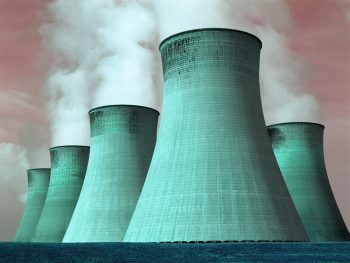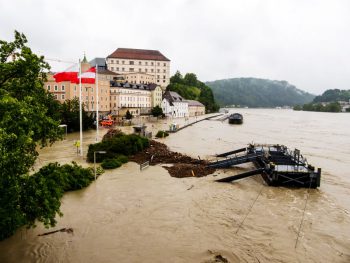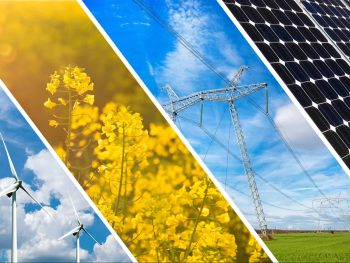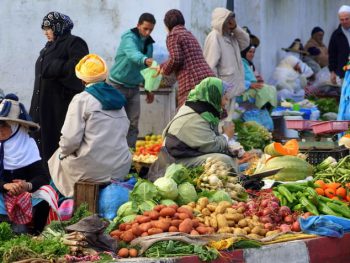Contributing to science based climate targets
The SR1.5 report highlights the strong benefits to humanity and ecosystems of keeping global warming to 1.5°C rather than 2°C above pre-industrial levels. IIASA researchers were intimately involved in the writing of the report, including in the capacity of coordinating lead author of Chapter 2 on mitigation pathways, and taking the lead on the analysis of sustainable development implications of mitigation summarized in Chapter 5. In addition, they were responsible for the compilation of a scenario repository underpinning important findings of the report, and were also contributing authors to various other chapters.
IIASA research critically underpins a wide range of findings of the IPCC report, from impacts and vulnerability to mitigation. One IIASA study [1] was specifically instrumental in illustrating the large difference between 2°C and 1.5°C in terms of exposure to multi-sectoral hotspots in Chapter 3 of the report (Figure 1). In addition, a dedicated study with a focus on mitigation [2] guided the report’s findings on the feasibility of reaching the 1.5°C target. The IIASA-led international CD-LINKS consortium contributed 36 scenarios to the IPCC assessment, while MESSAGE-GLOBIOM scenarios were used to illustrate the challenges in specific sectors and sources where greenhouse gas reductions are most difficult to achieve. In sum, two out of four illustrative pathways featured by the IPCC SR1.5 – the Shared Socioeconomic Pathway 2 (SSP2) and the Low Energy Demand (LED) scenario [3] – were from IIASA, where they were jointly developed by a number of the institute’s research programs.
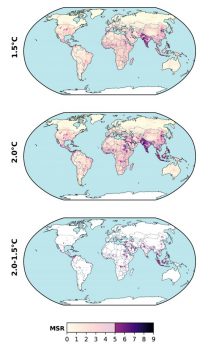
Figure 1: Multi-sector risk maps for 1.5°C and 2°C global average temperature change. The bottom panel shows the difference between the two temperature change cases. Darker colors indicate high risk due to multiple extreme events coinciding at the same time and place. [1]
These scenarios along with many others developed by the worldwide climate research community are part of a unique data set that underpins the IPCC report. IIASA hosts these scenarios for the community in a publicly accessible repository – the so-called Integrated Assessment Modeling Consortium (IAMC) 1.5°C Scenario Explorer [4].
The scenario explorer provides a critical service to the policy and scientific community. It includes 414 scenarios for future climate change developed by more than a dozen research teams from around the world. These scenarios provide information related to the energy system, greenhouse gas emissions, land use change, and other factors connected with climate change and sustainable development. It also includes visualization tools for exploring the data, so that policymakers and researchers in related fields like climate finance can explore different options for climate action and their potential consequences.
The aim of the new scenario explorer is to help increase the transparency of IPCC assessments, and facilitate better understanding of synergies and trade-offs of climate change mitigation options with sustainable development.
References
[1] Byers E, Gidden M, Leclere D, Burek P, Ebi KL, Greve P, Grey D, Havlik P, et al. (2018). Global exposure and vulnerability to multi-sector development and climate change hotspots. Environmental Research Letters 13: e055012
[2] Rogelj J, Popp A, Calvin KV, Luderer G, Emmerling J, Gernaat D, Fujimori S, Strefler J, et al. (2018). Scenarios towards limiting global mean temperature increase below 1.5 °C. Nature Climate Change 8 (4): 325-332.
[3] Grubler A, Wilson C, Bento N, Boza-Kiss B, Krey V, McCollum D, Rao N, Riahi K, et al. (2018). A low energy demand scenario for meeting the 1.5 °C target and sustainable development goals without negative emission technologies. Nature Energy 3 (6): 517-525.
[4] Huppmann D, Rogelj J, Krey V, Kriegler E, & Riahi K (2018). A new scenario resource for integrated 1.5°C research. Nature Climate Change 8: 1027-1030.
Further information
- Intergovernmental Panel on Climate Change (IPCC)
- Global Environment Facility, US
- United Nations Industrial Development Organization (UNIDO), Austria
Related research
